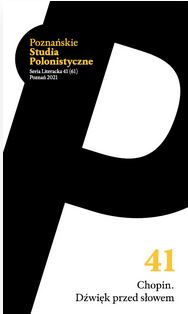Frédéric Chopin, entre exacerbation romantique du modèle vocal et innovations percussives : une mixité dynamique
Frédéric Chopin, Between Romantic Exacerbation of the Vocal Model and Percussive Innovations: a Dynamic Mix
Author(s): Martin LalibertéSubject(s): Music, 19th Century, History of Art
Published by: Wydawnictwo Poznańskie Studia Polonistyczne
Keywords: Chopin; musical models; piano music; organology; musical analysis;
Summary/Abstract: After some in-depth analysis, for instance, of the first Ballade in G minor (1836), Frédéric Chopin’s music reveals itself as a striking case of a musical equilibrium between two major musical tendencies. On the one hand, his music brings the reaching towards an idealised voice to a full and very convincing development. His musical themes sing most of the time while all the main characteristics of his writing explore continuous spaces, to the extent the piano can achieve. He uses many melodic chromaticisms and broad gestures, very voice-like phrasings ranging from the most delicate pianissimi to the extremely dramatic fortissimo, and other vocal features. On the other hand, his music is unavoidably written for a percussion instrument (the piano), makes much use of rhythms and often dances as well, while his accompaniments are thick with vertical features, accents and other percussive traits. In reality, Chopin’s music is in a striking state of equilibrium between the vocal and the percussive and constitutes a rich case of a mixed status between the two poles. Perhaps for one of the last times in Western music, Chopin is precisely at the point of equilibrium before the rise of the percussive that gave birth to much of the twentieth century’s music. Chopin’s music will remain a true and much beloved monument of equilibrium.
Journal: Poznańskie Studia Polonistyczne. Seria Literacka
- Issue Year: 2021
- Issue No: 41
- Page Range: 107-123
- Page Count: 17
- Language: French

